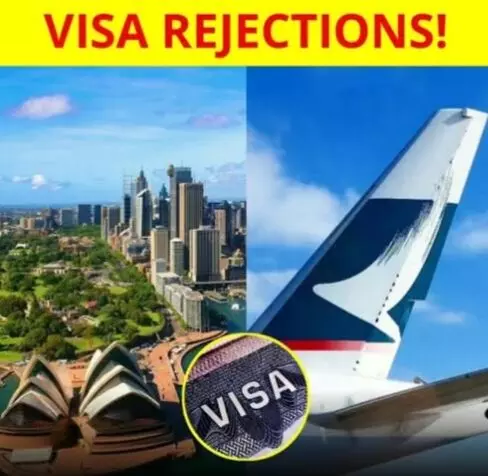Visa Walls Rising: How Increasing Rejections Are Shaping India’s Global Image

Images Credit Social Media
Historically, Indian travelers have held an enviable position in the global tourism and business sectors, consistently ranking among the most mobile communities worldwide. Yet, an unsettling shift has emerged in recent years — a sharp surge in visa rejection rates for Indian citizens by several countries. Data from 2024 paints a worrying picture: New Zealand rejected 32.5% of Indian applications, Australia followed with 29.3%, while the UK denied 17% of Indian visa requests. Even the Schengen area, a longtime favorite for Indian tourists, posted a 15.7% rejection rate. Compared to the relatively liberal pre-pandemic years, these numbers reveal not just statistical fluctuations but a significant transformation in global attitudes and policies toward Indian travelers.
This wave of rejections has not been without serious financial consequences. Indian travelers collectively lost approximately ₹664 crore in 2024 due to these refusals — a figure that reflects not just visa fees but also non-refundable expenses like hotel bookings, travel insurance, and airfares. The visa process, once a gateway to new opportunities, has become a source of economic and emotional strain for thousands of hopeful applicants. In an era where many countries demand upfront confirmations of travel arrangements, the risks attached to the application process have escalated, making the losses incurred by denied applicants even heavier.
At the heart of this trend lies a complex set of factors. In the aftermath of the COVID-19 pandemic, many nations recalibrated their immigration frameworks, prioritizing internal recovery, public safety, and employment security. Financial scrutiny has tightened, with applicants now needing to demonstrate higher income levels, more exhaustive documentation, and stronger personal and professional ties to their home country. For Indian applicants, navigating this increasingly restrictive environment has become progressively challenging.
Reinforcing this is India’s declining position on the Henley Passport Index, which fell from 80th to 85th in 2025. This ranking — a measure of the travel freedom offered by a nation’s passport — directly influences how other countries assess visa applicants. A lower rank implies diminished confidence in the passport's integrity, thereby subjecting its holders to stricter scrutiny.
Interestingly, the United States, often at the forefront of global visa debates, offers a nuanced counter-narrative. While the Trump administration’s hardline policies once pushed Indian visa rejection rates as high as 28% in 2019, by 2024 this figure had dropped to 16%. This decline suggests that visa policy trends are not uniformly tightening, but rather, they fluctuate in alignment with changing geopolitical priorities, bilateral relations, and domestic agendas. The U.S. example also demonstrates that improving diplomatic engagement can directly influence mobility outcomes for Indian citizens.
However, the wider implications of rising visa refusals go well beyond the immediate inconvenience to travelers. At a diplomatic level, it signals potential trust deficits and emerging stereotypes about Indian mobility, financial stability, or compliance behavior. Visa policies, while framed as administrative decisions, are often quiet barometers of international relationships and perceptions. A sustained increase in rejection rates could quietly erode India’s standing in global forums, discourage cultural and academic exchanges, and complicate trade negotiations. For instance, smaller Southeast Asian nations like Indonesia and Malaysia, which have also reported higher rejection rates for Indian travelers, may be reacting to issues like over-tourism, local resource strain, or labor market disruptions — but these reasons, when not openly articulated, tend to reinforce unhelpful biases.
Solving this problem demands strategic intervention on multiple fronts. Diplomatically, India must pursue more assertive negotiations for transparent and equitable visa agreements. Establishing reciprocal policies could provide a useful bargaining chip, encouraging countries to moderate their screening processes for Indian citizens. Domestically, streamlining the visa application process, offering clearer guidance, and better preparing applicants for the intricate demands of international documentation can reduce preventable rejections.
Furthermore, expanding consular assistance and grievance redressal mechanisms would ease the burden on travelers facing arbitrary or opaque rejections. The government can also launch awareness campaigns, educating applicants about updated requirements and common mistakes to avoid during the application process.
In essence, this rise in visa rejections reflects not only shifting global immigration priorities but also an evolving perception of India’s global position in the post-pandemic world. The statistics point to a clear message: global mobility is no longer guaranteed, even for a nation as dynamic as India. It challenges India to introspect about its international image, the strength of its diplomatic engagements, and the preparedness of its citizens in navigating an increasingly protectionist global order. If left unaddressed, this growing pattern risks entrenching negative assumptions and diminishing opportunities for Indians abroad. By actively engaging with international partners and advocating for a fairer, more transparent visa regime, India can reclaim its citizens’ rightful access to global opportunities — restoring both mobility and trust in the process.
